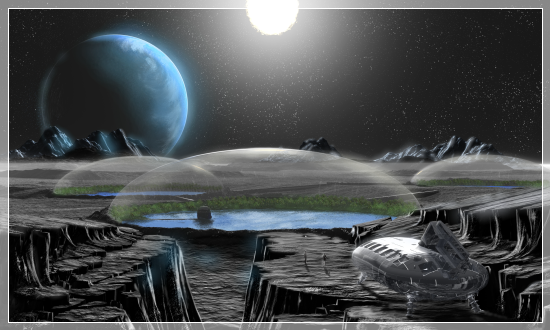New Moon - Dorad & Sirius
Main menu:
- D&S Home
-
Concept
-
 Introduction
Introduction
-

 The Cetacean Human Age
The Cetacean Human Age
-
 Environments
Environments
-

 Paxford One
Paxford One
-

 Pacific Chakra
Pacific Chakra
-

 New Moon
New Moon
-

 Narwhal
Narwhal
-

 Lagrange Chakra
Lagrange Chakra
-
 Timeline
Timeline
-

 The Chronology
The Chronology
-
- Chakralog
- Extra

As the most ambitious lunar colonisation project to date, New Moon is primarily a network of craters converted to habitable biospheres. The craters are mainly water-filled, with trees and plants on the surrounding inner slopes. Each environment is covered by a transparent self-sealing nano-polymer roof. Power for the many biospheres is supplied by vast solar energy farms, covering many square kilometres of the Moon’s surface. Production of solar power has increased over time, enabling New Moon to supplement the energy provided for Earth by the SBSP network.
The New Moon Consortium was formed by numerous companies and organisations, including Chakra, to create lunar settlements compatible with cetaceans and humans together, whereas the earlier individual Moon bases had been designed and built with only people in mind. The project was initiated by adapting relatively small craters. To make each crater suitable for habitation, the fine lunar soil, or regolith, was fused by a microwave sintering process, creating a ceramic glass-like surface. By varying the heat used to fuse the soil, different areas could have a specific colour or range of colours. Most of the regolith was converted to a particular form of ceramic, reflecting white light in the blue area of the spectrum when covered by water, thereby adding an aesthetic quality to the biospheres.
The involvement of Chakrangers was of particular importance to New Moon’s feasibility. The various teams were able to transport many carbonaceous [C-class] asteroids containing water, which provided the vast quantities required for the crater biospheres.
The success of those first conversions, along with technology advancements, allowed larger biospheres to be created. The larger craters offer greater potential, for taking advantage of the Moon’s gravity being only one sixth of that on Earth. The most adventurous aspect is the possibility for humans and dolphins to literally fly, wearing suits designed specifically for the purpose.
With most of the inhabited craters linked by a cetacean human transit system, constructed in more recent years, New Moon offers humans and dolphins an imaginative and exciting experience.


A large crater ninety-three kilometres in diameter, situated close to the Mare Imbrium region on the northern nearside of the Moon, Copernicus is today the most advanced biosphere in the New Moon network. Consistent with the other lunar biospheres, Copernicus Chakra is mainly water-filled; its vast size creating a virtual sea. The crater’s inner slopes are mostly terraced, allowing small forest areas to be formed. The protective roof consists of individual nano-polymer sections, supported by an array of towers sited at equidistant points on the crater floor and rim.
As with the earlier biospheres, it was the telekinetic abilities of numerous Chakranger teams, which made the concept of Copernicus Chakra feasible. A giant solar collector was assembled and manipulated in lunar orbit, allowing concentrated sunlight to fuse the regolith into a glass-like surface on a vast scale.
The mountains and floor mounds in the central area are high enough for the peaks to remain above
sea-level, producing in effect, a group of small islands; the location for Chakracademy. The sea-based facility is similar in design to Chakra’s homes on Earth, with various interconnected floating modules surrounding one of the natural islands. For cetacean human flights, the spacious central hall can be readily converted into a departure port. A giant hydraulic arm based on the island and connected to the hall, raises the circular structure to a height of two hundred metres above the sea. Equally spaced sections of the building’s wall, hinged at the floor, are lowered outwards to form launching platforms, enabling many cetaceans and humans to take flight at the same time.
Copernicus Chakra being so much larger than the other biospheres, makes all flying generally a greater experience for participants and spectators alike. Visitors to Copernicus Chakra for the first time, never fail to be impressed by the sight of a hundred or more humans and dolphins flying together within the most spectacular of New Moon’s environments.